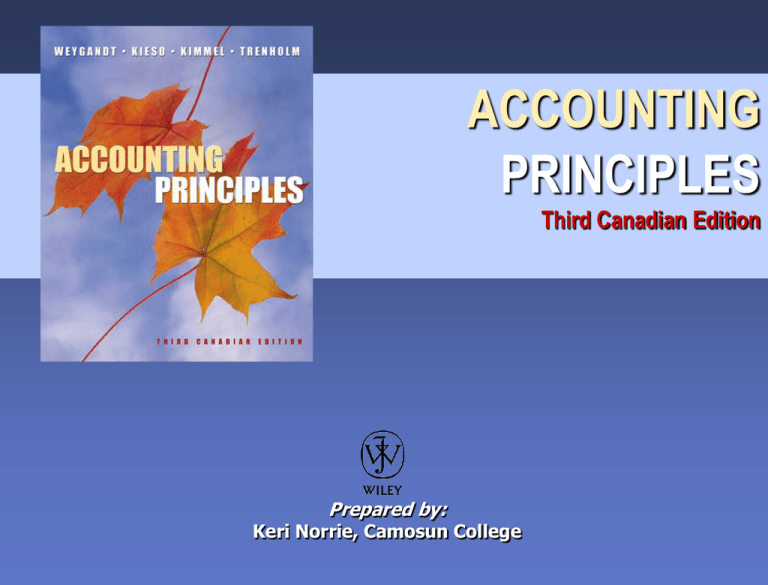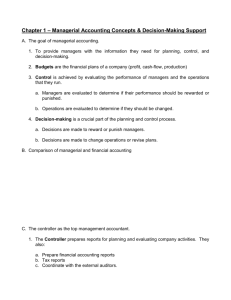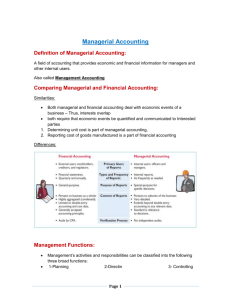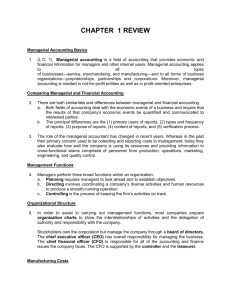
ACCOUNTING
PRINCIPLES
Third Canadian Edition
Prepared by:
Keri Norrie, Camosun College
CHAPTER 19
MANAGERIAL
ACCOUNTING
MANAGERIAL ACCOUNTING
BASICS
Managerial accounting is a field of accounting
that provides economic and financial
information to managers and other internal
users to assist them in making decisions and
evaluating the effectiveness of those decisions.
ILLUSTRATION 19-1
DIFFERENCES BETWEEN FINANCIAL AND
MANAGERIAL ACCOUNTING
Financial Accounting
Managerial Accounting
External users such as
shareholders, creditors, and
regulatory agencies.
Internal users such as managers
and officers.
Financial statements, issued at
least annually.
Internal reports, issued as
frequently as needed.
General-purpose information for all
users.
Special purpose for specific
decisions.
Reports pertain to company as a
whole; are highly aggregated; are
limited to double-entry accounting
and cost data; use standard of
GAAP.
Reports pertain to subunits of the
company; are very detailed; can
include any relevant data; use
standard of relevance to decisions.
Annual independent audit.
No independent audit.
MANAGERIAL ACCOUNTING BASICS
Management Functions
1. Planning
•
•
Management looks ahead and establishes
objectives
A key objective is to add value to the business
2. Organizing and Directing
•
•
Management coordinates the company’s
diverse activities and human resources to
produce an operation that runs smoothly
This function relates to the implementation
of planned objectives
MANAGERIAL ACCOUNTING BASICS
Management Functions
3. Controlling
•
•
The process of keeping the firm’s activities
on track
Management determines whether planned
objectives are being met and whether changes
are necessary
Managerial accounting assists in all three
management functions by providing the
necessary information to management.
MANAGERIAL ACCOUNTING BASICS
Contemporary Developments
• The role of managerial accounting has
expanded to meet the information needs of
businesses
• The following trends have contributed to this
expanded role:
•
•
•
•
•
•
Value Chain Management
Technological Change
Just-In-Time Inventory Methods
Product Quality Management Systems
Activity-Based Costing (ABC)
Cost Management
MANAGERIAL COST CONCEPTS
To perform the three managerial functions effective and
reliable information is needed. Cost information is when
answering questions such as the following:
What costs are
involved in making a
product?
What impact will
automation have
on total costs?
If production is
decreased, will
costs decrease?
How can costs best
be controlled in the
organization?
MANAGERIAL COST CONCEPTS
Manufacturing Costs
• Manufacturing consists of activities and
processes that convert raw materials into
finished goods
• Manufacturing costs are typically classified as
follows:
• Direct materials
• Direct labour
• Manufacturing overhead
MANAGERIAL COST CONCEPTS
Manufacturing Costs
Raw materials represent the basic materials and
parts that are to be used in the manufacturing
process. They can be classified as either:
Direct Materials
Raw materials that can be
physically and conveniently
associated with the finished
product during the
manufacturing process.
Or
Indirect Materials
Raw materials that cannot be easily
associated with the finished
product. Indirect materials are
accounted for as part of
manufacturing overhead.
MANAGERIAL COST CONCEPTS
Manufacturing Costs
• Direct labour
• The work of factory employees that can be
physically and conveniently associated with
converting raw materials into finished goods.
• Indirect labour
• The labour costs that have no physical
association with the finished product or it is
impractical to trace the costs to the goods
produced
• Like indirect materials, indirect labour is
classified as manufacturing overhead
MANAGERIAL COST CONCEPTS
Manufacturing Costs
Manufacturing overhead costs are indirectly
associated with the manufacture of the finished
product such as:
• Indirect materials and labour
• Amortization on factory buildings and
equipment
• Insurance, taxes, and maintenance on
factory facilities
Allocating manufacturing overhead to specific
products is challenge faced in managerial
accounting .
MANAGERIAL COST CONCEPTS
Product versus Period Costs
The three manufacturing costs are also known as
product costs since they become the cost of the
finished product.
Direct materials
Direct labour
Manufacturing overhead
Under the matching
principle, the product costs
are expensed when the
finished goods are sold.
Finished Goods Inventory
Cost of Goods
Sold Expense
MANAGERIAL COST CONCEPTS
Product versus Period Costs
• Non-manufacturing costs are known as period
costs as they are related to a specific time
period rather than to a saleable product
• Period costs include operating costs that are
deducted from revenues in the period incurred
• Operating costs are often subdivided into:
selling expenses (e.g. delivery and promotion)
administrative expenses (e.g. accounting and
personnel management)
ILLUSTRATION 19-2
Product versus Period Costs
All costs
Product costs
Manufacturing Costs
Period costs
Non-manufacturing Costs
Direct Materials
Selling Expense
Direct Labour
Administrative
Expenses
Manufacturing
Overhead
MANUFACTURING COSTS IN FINANCIAL
STATEMENTS: Balance Sheet
Manufacturing Company
Balance Sheet
December 31, 2005
Current assets
Cash
Receivables (net)
Inventory:
Raw materials
Work in process
Finished goods
Total current
assets
$
16,700
18,400
24,600
42,500
71,900
59,700
$235,000
A manufacturing company’s balance sheet will
have three inventory accounts based on the stage
of production.
MANUFACTURING COSTS IN FINANCIAL
STATEMENTS: Income Statement
Merchandising Company
Beginning
Merchandise
Inventory
+
Cost of Goods
Purchased
-
Ending
Merchandise
Inventory
Manufacturing Company
Beginning
Finished Goods
Inventory
+
Cost of Goods
Manufactured
-
Ending
Finished Goods
Inventory
Unlike a merchandise company which
purchases its products, a manufacturer
has cost of goods manufactured
=
Cost of Goods
Sold
=
ILLUSTRATION 19-6
MANUFACTURING COSTS IN FINANCIAL
STATEMENTS: Income Statement
MANUFACTURING COMPANY
Partial Income Statement
For the Year Ended December 31, 2005
Cost of goods sold
Finished goods inventory, January 1
Cost of goods manufactured
Cost of goods available for sale
Finished goods inventory, December 31
Cost of goods sold
$ 24,600
370,000
394,600
19,500
$ 375,100
ILLUSTRATION 19-7 MANUFACTURING COSTS IN
FINANCIAL STATEMENTS
Income Statement Cost of Goods Manufactured
Beginning
Work In Process
Inventory
Total Cost of
Work In Process
+
-
Total Current
Manufacturing
Costs
Ending
Work In Process
Inventory
Total Cost of
= Work In Process
=
Cost of Goods
Manufactured
ILLUSTRATION 19-8
MANUFACTURING COSTS IN FINANCIAL
STATEMENTS
The Cost of
Goods
Manufactured
Schedule – as
shown on the
right is an
internal financial
schedule that
shows each of
the cost
elements
explained in
Illustration 19-7.
OLSEN MANUFACTURING CORPORATION
Cost of Goods Manufactured Schedule
Year Ended December 31, 2005
Work in process, January 1
Direct materials
Raw materials inventory, January 1
Raw materials purchases
Total raw materials available for use
Less: Raw materials inventory, December
31
Direct materials used
Direct labor
Manufacturing overhead
Indirect labor
Factory repairs
Factory utilities
Factory amortization
Factory insurance
Total manufacturing overhead
Total manufacturing costs
Total cost of work in process
Less: Work in process, December 31
Cost of goods manufactured
$ 18,400
$ 16,700
152,500
169,200
22,800
$ 146,400
175,600
14,300
12,600
10,100
9,440
8,360
54,800
376,800
395,200
25,200
$ 370,000
COPYRIGHT
Copyright © 2004 John Wiley & Sons Canada, Ltd. All rights reserved.
Reproduction or translation of this work beyond that permitted by
Access Copyright (The Canadian Copyright Licensing Agency) is
unlawful. Requests for further information should be addressed to the
Permissions Department, John Wiley & Sons Canada, Ltd. The
purchaser may make back-up copies for his or her own use only and
not for distribution or resale. The author and the publisher assume no
responsibility for errors, omissions, or damages caused by the use of
these programs or from the use of the information contained herein.







